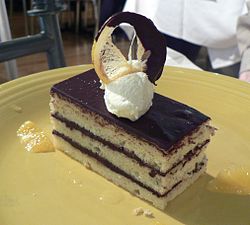Layer cake
A layer cake is a cake consisting of multiple layers, usually held together by frosting or another type of filling, such as jam or other preserves. Most cake recipes can be made into layer cakes; butter cakes and sponge cakes are common choices. Frequently, the cake is covered with icing, but sometimes, the sides are left undecorated, so that the filling and the number of layers are visible. Popular flavor combinations include the German chocolate cake, red velvet cake, Black Forest cake, and carrot cake with cream cheese icing. Many wedding cakes are decorated layer cakes. In the mid-19th century, modern cakes were first described in English. Maria Parloa's Appledore Cook Book, published in Boston in 1872, contained one of the first layer cake recipes. Another early recipe for layer cake was published in Cassell's New Universal Cookery Book, published in London in 1894. [edit]Older forms Dobos torte is an older form of layer cake. An older form of layer cake is common in southern and eastern Europe. In Ukraine and Russia, people still make these cakes in the old traditional way. The cake batter is baked in a frying pan in thin layers, about a centimeter thick in the finished stack. These layers are then covered with a thin layer of cream and/or jam and stacked 7 or 8 layers high. This stack, which is the same height as the typical Western layer cake, is then frosted so that the structure is not visible. At first glance, these cakes look much like a German konditorei style cake such as the Black Forest cake. [edit]Comparison Layer cakes always serve multiple people,

so they are larger than cupcakes, petit fours, or other individual pastries. A common layer cake size, which is baked in nine-inch round cake pans, typically serves about 16 people. Unlike the Vietnamese Banh da l?n or Swiss rolls, layer cake is assembled from several separate pieces of cake. A sheet cake can become a layer cake if it is cut into pieces and reassembled with frosting or other filling to form layers.Fruit preserves are preparations of fruits, vegetables and sugar, often canned or sealed for long-term storage. The preparation of fruit preserves today often involves adding commercial or natural pectin as a gelling agent, although sugar or honey may be used, as well. Before World War II, fruit preserve recipes did not include pectin, and many artisan jams today are made without pectin. The ingredients used and how they are prepared determine the type of preserves; jams, jellies and marmalades are all examples of different styles of fruit preserves that vary based upon the ingredients used. Many varieties of fruit preserves are made globally, including sweet fruit preserves, such as strawberry, as well as savoury preserves of culinary vegetables, such as tomatoes or squash. In North America, the plural form "preserves" is used to describe all types of jams and jellies. In British and Commonwealth English most fruit preserves are simply called jam, with the singular preserve being applied to high fruit content jam, often for marketing purposes. Additionally, the name of the type of fruit preserves will also vary depending on the regional variant of English being used.